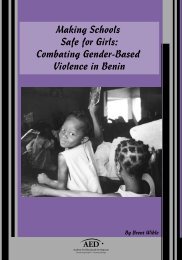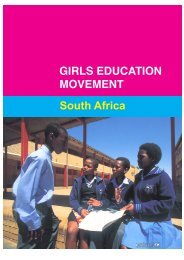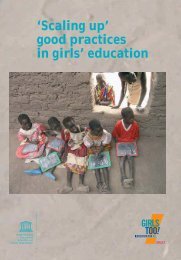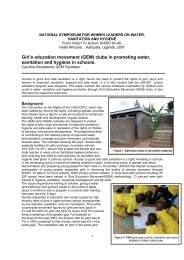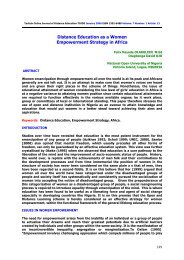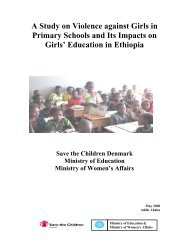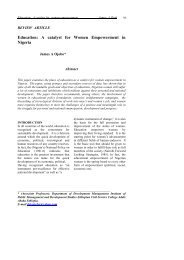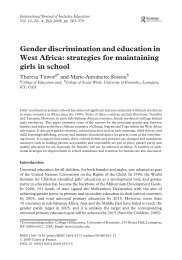Promoting basic education for women and girls ... - library.unesco-ii...
Promoting basic education for women and girls ... - library.unesco-ii...
Promoting basic education for women and girls ... - library.unesco-ii...
You also want an ePaper? Increase the reach of your titles
YUMPU automatically turns print PDFs into web optimized ePapers that Google loves.
Pregnancy continues to be a leading cause <strong>for</strong> dropping out<br />
of school of most teen-age <strong>girls</strong>. 27 per cent of hospital deliv-<br />
eries are 15–19 year old <strong>girls</strong>. Ef<strong>for</strong>ts have been made by<br />
different organizations working with youth, but the impact is<br />
hardly measurable, as more <strong>girls</strong> drop out of school because<br />
of pregnancy. Young <strong>girls</strong> are faced with many challenges<br />
as they follow their line of growth from puberty to teenage<br />
stage <strong>and</strong> young adults. The home environment is not sup-<br />
portive. Proper <strong>education</strong> <strong>and</strong> counselling is something that<br />
homes do not offer.<br />
Swazil<strong>and</strong><br />
31S<br />
situation is one of ‘apparent gender balance’. In the early<br />
years of secondary <strong>education</strong>, <strong>girls</strong> are in the majority, but<br />
the table turns in favour of the boys in later years.<br />
In the 1999 school year, <strong>for</strong> example, <strong>girls</strong> constituted<br />
51.71 per cent of children in the first year of secondary<br />
<strong>education</strong>. In the fifth year, the proportion of <strong>girls</strong><br />
was 46.22 per cent. The corresponding proportions <strong>for</strong><br />
the year 2000 were 52.6 per cent <strong>girls</strong> in the first year <strong>and</strong><br />
48.60 per cent in the fifth year.<br />
In addition, <strong>girls</strong> in Swazil<strong>and</strong> are still subject to<br />
the negative influences on <strong>girls</strong>’ <strong>education</strong>, which are at<br />
work in other countries of Africa. Thus, poverty, pockets<br />
of resistance to Western <strong>education</strong> (<strong>and</strong> particularly negative<br />
attitudes to schooling <strong>for</strong> <strong>girls</strong>), gender stereotyping<br />
in the choice of careers <strong>and</strong> areas of study, unwanted<br />
pregnancies, etc., are still stark realities in the country. As<br />
is very well known, these factors contribute to non-enrolment,<br />
drop-out, irregular attendance, repetition, <strong>and</strong> poor<br />
per<strong>for</strong>mance among <strong>girls</strong>.<br />
The threat of teenage pregnancy<br />
Extracts from FAWESWA, Needs Assessment<br />
Report on Teenage/Young Mothers, November 2000



